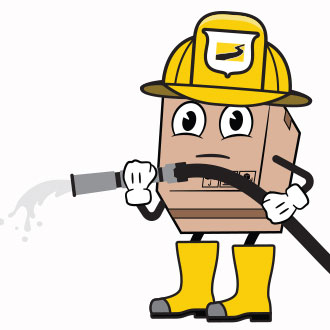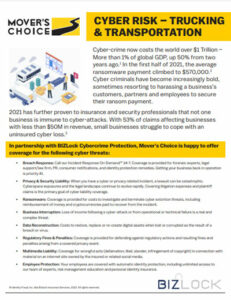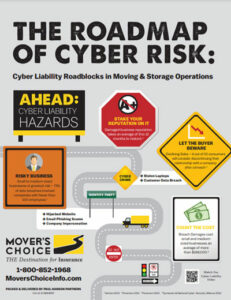
Wildfires & Warehouses
What you Need to Know about Protecting Customer Property
Wildfire season is not my favorite time of year. It’s pretty scary…I’m tinder after all. As of this week more than 45% of the Continental U.S. is in drought conditions.
I may be just a cardboard box, but even I know that roasting marshmallows over a campfire wouldn’t be too bright right now in the 27 states experiencing drought.
For those of you with operations in wildfire-prone states, check out my Wildfire Preparedness Checklist for tips for prevention through evacuation on the MC Dispatch Resource Center.
And if you have warehouse storage operations, you’ve got to be ready to “move it, move it” if a wildfire is threatening your location! Be prepared to pack up your customers’ property and move it out of harm’s way so it doesn’t go up in smoke. Save a box today with “Sue and Labor” coverage: It will compensate you for the costs involved in seeking to prevent damage to customer property that is in your care, custody and control. It’s an enhancement built into the Mover’s Choice inland marine policy. Unlike more common policies like property and general liability, not all insurers offer it and some just offer it as an endorsement to an existing property policy that would not cover goods in your care, custody and control.
Stay safe. Do a rain dance. Make ’smores in your toaster oven. Thank your Wildland firefighters!

House Transportation Committee calls for Truck Parking Funding
On June 7, Transportation Secretary Pete Buttigeig and U.S. House of Representatives called for funding to increase resources for the expansion of parking facilities for truck drivers. These programs designed to expand regional freight and infrastructure projects, such as the Infrastructure for Rebuilding America (INFRA), Rebuilding American Infrastructure with Sustainability and Equity (RAISE), and the national infrastructure project assistance program.

Controversial Proposed Electronic Speed Limit Regulators Comment Period Extended
Federal regulators working on a proposal that would create a nationwide truck speed limit using electronic engine devices extended the comment period on the controversial move to July 18. The Federal Motor Carrier Safety Administration (FMCSA) has already received more than 15,500 comments. Trucking officials of national and multi-regional trucking officials support the plan while American Trucking Associations and the Owner-Operator Independent Drivers Association (OOIDA) are opposed.

CTA called US officials recommendation that SCOTUS decline hearing of CA AB-5 law “head-scratchingly wrong”
U.S. solicitor general’s recommendation that the U.S. Supreme Court decline to hear an appeal of a CA state law [AB-5] aimed at reclassifying owner-operators as motor carrier employees. California Trucking Association called recommendation “head-scratchingly wrong” that would “upend industry” and have “profoundly destructive effects.”

ATA President Praises Bi-Partisan Effort for $1Trillion Infrastructure Bill
American Trucking Association President, Chris Spears, has praised the work put in to the bi-partisan effort to get the bill passed. The bill is a 38% increase in spending that guarantees funding and gives states five years of certainty.
Monthly Spotlight:
Safety Incentive Program

Author: Brandon Laam,
Assistant Vice President
Coverage Question of the Month:
Have you Evaluated Lowering Your
UM/UIM Limits on Your Policy?
By Terri Moran, Chief Underwriter, Mover’s Choice
When was the last time you evaluated both the necessity and advisability of carrying high limits for Uninsured or Underinsured Motorists. First, let’s look at the intent of the coverage. It is intended to cover medical expenses, lost wages and repair costs when an accident occurs and the other driver is uninsured. As examples, it tends to serve those individuals who do not have recourse through their own health insurance or physical damage coverage on their vehicles.
What does it do for commercial risks? It is basically serving to stack limits of coverage, and that is at a cost.
In our commercial transportation risks, we generally have trucks whose sole occupants are either employees, and sometimes, Independent Contractors. They are covered by the employer through Workers’ Compensation, or in the situation of the Independent Contractors, will often purchase Occupational Accident Coverage.
Not only is coverage costly on a per vehicle basis, but in the event of an accident, these loss dollars become a part of the experience rating for both the automobile, and if the employee was injured, Workers’ Compensation. With UM/ UIM costs reaching upwards of $150-$200 per vehicle, depending on the limit and type of vehicle, this can really add up and is in addition to the other ways you have already elected to protect your employees and vehicles.
The cost of risk has continued to rise, and this is one way to control your upfront costs along with costs down the road. It is our intent to work with you to control these costs and offer only what is statutorily required. Of course, if you have reason, or wish to have higher limits, we will be able to accommodate those requests as well.
Feel free to reach out to you underwriter or me if you have any thoughts or questions.
~ Terri Moran
If you have coverage questions that you would like us to address next month, please submit your questions to Brandon Laam at . If your question is selected, we will send you a $25 Amazon Gift Card!




